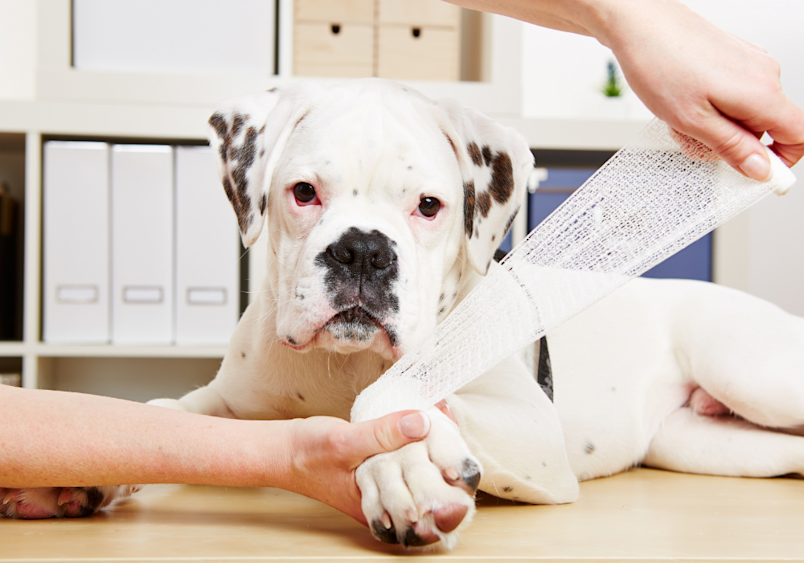
"Why is my dog limping?" If you've found yourself asking this question, you're likely feeling concerned – and rightly so. Seeing your dog suddenly start limping, even if they don’t seem to be in pain, can be alarming for any pet owner. Don’t panic, but do pay attention. Limping is your dog's way of signaling that something isn't quite right, and understanding the potential causes is the first step in helping them feel better.
A dog limping on their front or back leg is a common sight in veterinary medicine with lameness occurring in an estimated 56% of dogs sometime in their lifetime. Yes, dog limping is very prevalent, but what may be even more frustrating is that it has so many causes and can be a long process to diagnose and treat. But don’t worry, we’re here to help you find out why your dog is limping and how to help them.
Why Is My Dog Limping?
The core answer is simple: your dog is limping because something is causing them pain or discomfort in their leg or paw, ranging from minor issues like a paw injury to more serious problems like arthritis or a broken bone.
The legs are an intricate machine made up of muscles, bones, ligaments, tendons, other connective tissue, nerves, vasculature, and skin. That’s a lot of areas for problems to occur.
Injury or Trauma Can Cause Dog Limping
Something as minor as a misstep or as serious as a car accident can cause trauma resulting in limping.
Sprains and Strains: These happen when muscles or connective tissues are overstretched or torn. Exercise or stepping awkwardly can cause them. They result in pain, swelling, and limping.
Fractures (Broken Bones): Fractures to any of the bones in the leg, of which there are many, can result in limping. Fractures to larger bones like the femur or tibia in the hindleg or the humerus, radius or ulna in the front leg are typically more noticeable, but a fracture in the tiny bones of the wrist or ankle can cause limping all the same.
Soft Tissue Injuries (Bruises): Muscles and skin can be bruised. Bruises hurt dogs too! This pain also leads to limping.
Joint Issues Can Cause Dog Limping
Joints are where bones connect, allowing legs to bend. These connections, unfortunately, are also common sites for problems that can cause limping.
Osteoarthritis: Osteoarthritis happens when there is degradation of the cushiony parts of joints, causing a lot of inflammation, pain and limping. While more common in older pups, injuries and joint anatomy can cause osteoarthritis in younger dogs as well.
Autoimmune Arthritis: Arthritis can also be triggered by immune mediated diseases where the immune system attacks the joints. This creates inflammation, pain, and often causes dog limping. Examples include rheumatoid arthritis and systemic lupus erythematosus.
Dysplasia: Dysplasia is abnormal joint development where the bones forming the joint don't fit together correctly. This mismatch disrupts normal joint function, frequently causing pain, and resulting in limping in dogs. Hip dysplasia can cause limping on the back leg, while elbow dysplasia can cause front leg limping.
Infections and Inflammatory Conditions Can Cause Dog Limping
Dog limping isn't always caused by obvious injuries; sometimes, the culprit is something less visible – infections or inflammatory conditions within the leg itself. These issues can arise from a range of sources and manifest with various signs, limping being a key indicator. Microbes that cause infections can live just about anywhere, including in the components of a dog’s leg.
Bacterial Infections: Bacterial infections can occur in the bone, muscle, connective tissue or skin. Signs of infections in dogs can include limping, along with redness, swelling, heat, lethargy and even a fever.
Fungal Infections: Fungal infections, though less common in the leg, can also sometimes lead to limping. In contrast to bacterial infections which are often direct and localized, fungal infections that cause limping are frequently acquired from the environment and tend to be part of a more widespread, systemic illness in the dog.
Tick-Borne Illnesses: Though an infection of the leg can be caused by nearly any infective bacteria, tick-borne illnesses are common ones to think about depending on where you live. Common tick-borne illnesses known to cause limping in dogs include Lyme disease, Ehrlichiosis, Anaplasmosis, and Rocky Mountain Spotted Fever.
Nerve Issues Can Cause Dog Limping
Controlling the legs is quite a process that starts in the brain and ends in the muscle. In between, there are nerves that send the necessary signals.
Intervertebral Disc Disease (IVDD): Intervertebral disc disease is when the squishy discs that cushion the vertebra in the spinal column protrude into the spinal cord’s coveted space. If severe enough, it can pinch the spinal cord, causing inflammation and reduced function of the legs.
Spinal Injuries: Spinal injuries can do similar things that IVDD does, where the spinal cord gets angry and the legs stop working at full capacity.
Peripheral Neuropathy: Peripheral neuropathy is when there is damage or inflammation to the nerves of the legs, again reducing their function. Neuropathy can occur from trauma, toxins, or some diseases, such as diabetes.
Growths and Tumors Can Cause Dog Limping
The parts of the legs are growing and changing all the time and sometimes normal growth becomes excessive, creating growths or tumors that can lead to dogs limping.
Bone Tumors: Bone tumors, mainly osteosarcoma, tend to be very aggressive. So, besides causing a lot of pain and limping, they can also spread to other parts of the body.
Joint Tumors: Tumors can also arise within the joint itself, such as synovial cell sarcomas. These tumors in the joint can cause pain, swelling, and lameness.
Soft Tissue Masses: Soft tissue masses, both cancerous and benign, can cause limping due to pain but also, depending on where they’re located, because they get in the way of the normal mechanics of movement.
Paw and Toenail Issues Can Cause Dog Limping
The paws are really where the rubber meets the road. They encounter nearly every hazard that the rest of your dog’s body does, so it’s no wonder that issues here can lead to limping.
Cuts, Splinters or Foreign Objects: Cuts, splinters or foreign objects in the paws create a lot of swelling, sores, and pain that can lead to limping. This includes the pads, between the toes, and the tops of the feet.
Toenail Problems: Broken toenails may sound like a minor issue, but they can actually be quite painful. And a dog’s broken nail can bleed A LOT! If I’ve convinced you that broken toenails can be a problem, then let’s talk about ingrown toenails, when the nail grows long enough to curl around and back into the pad. Ouch, no wonder it can cause limping.

Why Is My Dog Limping on the Front or Back Leg?
Both the front and the back legs of dogs are similarly constructed, so it seems fair that many causes of limping span both the front and back regions. Strains to the muscles, sprains to the connective tissue, and fractures to the bone can occur in either front or back legs. Arthritis and infections can also happen in both areas, as can paw and nerve issues.
My Dog Is Limping on Their Front Legs
There are a few causes of limping that only occur in the front legs. Elbow dysplasia is the main one since elbows are only found in the front legs. Osteosarcoma, though it can happen anywhere, is more commonly found in the long bones of the front leg, and you may see more toenail injuries in the front paws if you have a digging doggy.
While limping on any leg may seem similar, it does look different in front versus back. They may pack that front leg, pulling it up and tucking it close, often toward their chest, or they might toe-touch when they have to walk, just barely letting the tip of their paw touch down. Don't be surprised to see them licking at the leg too, likely trying to find some relief and show you where it hurts.
You may notice swelling, wounds, or tenderness when you look at their front leg. Front leg lameness typically doesn’t keep dogs from jumping on the furniture or climbing stairs, but they may be less willing to exercise.
My Dog Is Limping on the Back Leg
Similar to the elbows, you’ll only see issues with hip dysplasia in the back legs. Along with this, you may also get ligamental injuries in the stifle, or knee joint, and you’re more likely to get spinal cord related issues in the back legs because of where the nerves controlling the hindlegs exit the spinal cord.
Dogs with pain that cause limping on back legs may have a harder time standing up, going up stairs, and won’t want to jump. They may also toe-touch when walking or pack the leg. As with the front, look for any signs of swelling, wounds, or redness.
Limping Without Visible Signs
Often, along with limping, your dog will have something visible on their leg or paw. Swelling, redness, or wounds will all help clue you into what’s going on, but what if there isn’t anything else?
Some causes of lameness won’t be visible on the outside of the leg. Things like dysplasia or arthritis aren’t going to look like anything but will still make your dog limp. Look for other signs to help you determine what is going on. Watch them for signs of stiffness, difficulty standing up or going up stairs, reluctance to jump or lift their leg to pee.
Monitor your pup for these signs and then see your vet.
My Dog Is Limping but Shows No Sign of Pain
Is your dog limping but not in pain? You might wonder if it's still serious. Even if your dog isn't yelping or crying, limping without obvious pain can still signal a significant problem. Remember, dogs are experts at hiding pain, and what seems like "no pain" to us could be subtle discomfort or other issues causing the limp.
Subtle Pain Signs Matter
Dogs often hide pain. Watch for subtle signs of discomfort: stiffness (especially after rest), reluctance to move or jump, favoring a leg, decreased energy, or subtle mood changes.
Chronic Discomfort
Conditions like early arthritis can cause low-grade, persistent aches. Dogs adapt but still limp due to this ongoing discomfort, even without obvious pain.
Beyond Pain
Neurological problems, weakness, altered sensation, or structural issues, not just pain itself, can cause limping. Because these issues can indicate significant underlying problems, a veterinary visit is highly recommended if your dog is limping but shows no sign of pain.

When to Seek Veterinary Care for Dog Limping
Sometimes limping in dogs is fairly short lived and goes away on its own after a little rest. Other times, it’s an emergency situation that requires immediate care. See your vet if your dog’s limping is sudden, there is a noticeable deformity, or they show signs of a dog in pain. This can include excessive panting, whining, restlessness, crying out when the area is touched, or unwillingness to eat or exercise.
Your vet will start with an exam of the leg in question. They’ll watch your dog walk, sit, and stand to see how much they are using the leg. They will then feel it and move the joints to note areas of pain. X-rays are often needed to get a look at the bones and their surrounding tissues.
The treatment for limping in dogs will depend on the cause and may include surgery to fix fractures, repair connective tissue injuries, or remove masses. Infections will likely require medications and potentially drainage. Wounds may require a good cleaning, bandaging, maybe stitching and medications. Anti-inflammatories and rest may be all that’s required for sprains and strains.
Supporting Your Limping Dog at Home
Whatever the cause of your dog’s limping, rest is often prescribed to allow the leg to heal. This means limited exercise for potty breaks only.
Make your pup comfy cozy with a thick bed that supports their body and put food and water within easy reach. You may think about removing throw rugs or other obstacles that may be in their way to food and water, their bed, or the backyard.
Consider using supportive devices such as harnesses or ramps to help your pup get around. Harnesses provide a place for you to hold onto them while they’re walking, while ramps help them get into the car or onto the couch without jumping.
How Pet Insurance Can Help with Dog Limping
When you're worried and asking, "Why is my dog limping?", your mind is on their health and getting them better. What you might not be immediately thinking about are the potential veterinary bills. But diagnosing the cause of dog limping can involve vet exams costing $50-$200, tests like X-rays ($100-$500+) or lab work, and treatments can range from medication to surgery. For instance, surgery to repair a torn cruciate ligament can easily be $3,000 to $7,000 or more. These costs can add up unexpectedly, and quickly.
That's where a dog insurance can be a real lifesaver. It's there to help with those unplanned vet expenses that come with illnesses and injuries, including many of the reasons for dog limping. A good policy can reimburse a significant portion of covered costs, which relieves the financial worries so that you can focus on your dog getting the best care.
To make pet insurance truly work for you, planning ahead is essential. You need to have a policy in place before your dog is limping, since pre-existing conditions aren't typically covered. It’s all about preparing for those unexpected health moments down the road, for your dog’s sake and your own.
Overcoming Dog Limping
As a vet, “Why is my dog limping?” is a very common question that brings pet parents and their limping dogs in to see me. From minor sprains to serious underlying conditions, a limp is always your dog's signal to pay attention. Don't wait and wonder. Remember, your veterinarian is your best partner. Getting their expert diagnosis is key to understanding your dog’s limp and taking the right steps to ensure their comfort and mobility.
The fact that you've noticed your dog is limping show that you're an attentive pet parent and that you're listening to your pup tell you what's wrong in the only way they can. Now, with more knowledge, you can get to the root of the problem and get back to your walks in the park and endless games of fetch.